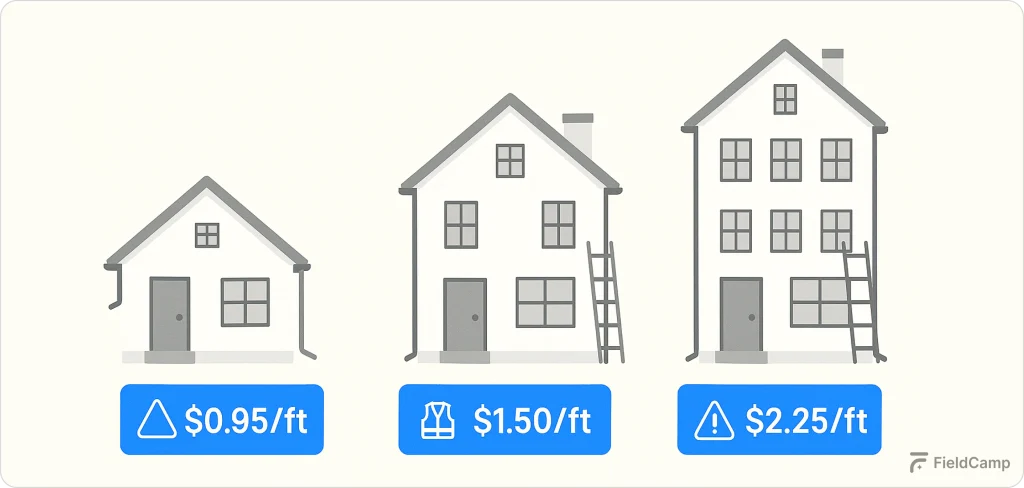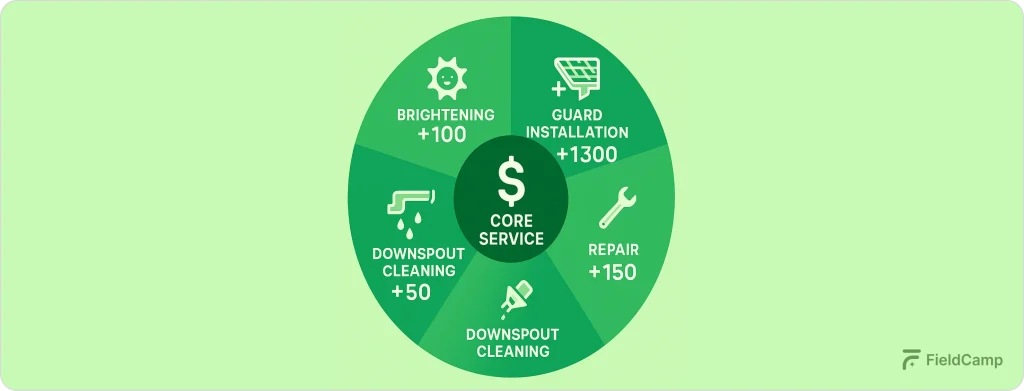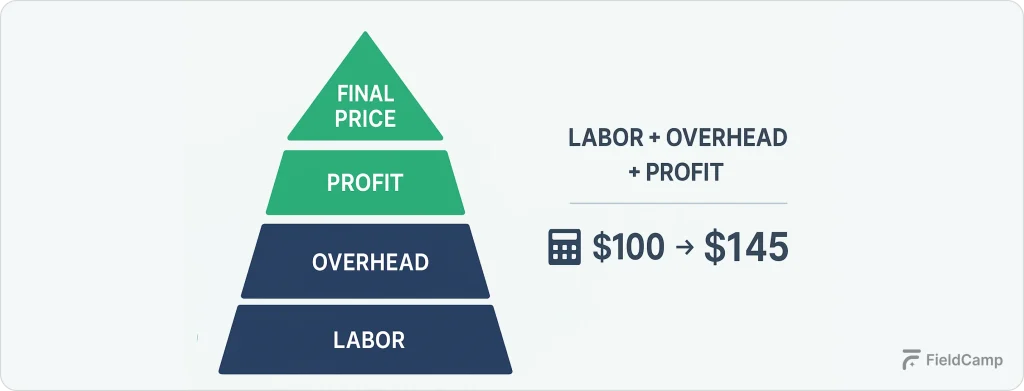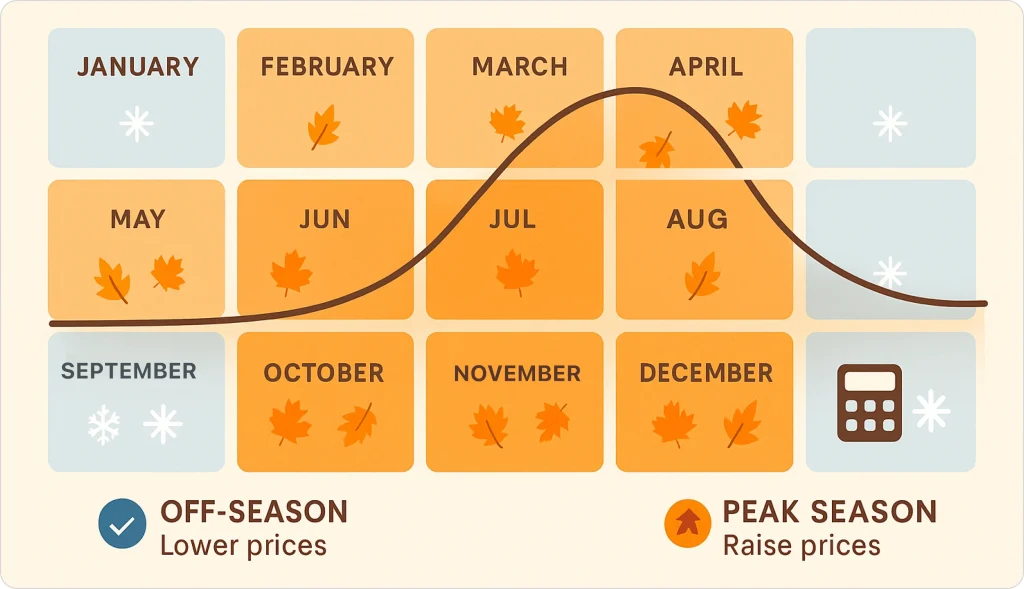How Much to Charge for Gutter Cleaning in 2025
June 25, 2025 - 19 min read

June 25, 2025 - 19 min read

Table of Contents
| TL;DR While most gutter cleaning pricing guides target homeowners, this comprehensive guide teaches contractors how to price jobs profitably at $0.95-$2.25 per linear foot using proven strategies that account for complexity, regional rates, and healthy profit margins. |
If you’re still quoting gutter cleaning jobs based on a gut feeling—or worse, copying your competitor’s rates—you’re leaving serious money on the table. The difference between average contractors and profitable pros lies in one thing: a strategic pricing system that reflects your real costs, your market, and your value.
Most pricing guides online are written for homeowners, not contractors. That’s why we created this contractor-first guide—to help you charge smarter, not just harder. Whether you’re cleaning 150 linear feet on a one-story ranch or scaling multi-story complexes with safety gear in tow, you need rates that protect your margins and win the job.
Need help fast?
Inside this guide, you’ll learn how to price per linear foot, factor in debris, height, insurance, and regional labor rates—and how to turn one-off cleanings into recurring revenue. If you’re ready to stop guessing and start growing, this is the pricing blueprint built for you.
KEY HIGHLIGHTS
Best Pressure Washing Pricing Tactics to Follow in 2025
The gutter cleaning industry operates within the broader $8 billion U.S. exterior cleaning market. This usually covers a straightforward cleaning on an average one- or two-story home. In terms of unit pricing, that translates to roughly $0.95 to $2.25 per linear foot of gutters on the house.

Understanding these baseline numbers helps contractors position their services appropriately. However, successful pricing goes beyond simply matching market averages. You need to consider your unique value proposition, service quality, and local market conditions.
National Pricing Breakdown:
Residential gutter cleaning services typically involve straightforward single or two-story homes with standard gutter configurations. Most standard homes have 125–200 linear feet of gutter, so the math works out to about $125–$250 in many cases.
Commercial projects present different challenges and opportunities. Commercial gutter cleaning might include office buildings, retail stores, apartment or condo complexes, warehouses, schools, and so on. These jobs often involve larger gutter systems or multiple structures. The complexity often justifies higher total pricing, even if the per linear foot rate remains similar.
For contractors developing their service pricing guide, it’s crucial to establish separate rate structures for residential and commercial work. Commercial jobs typically require additional insurance coverage, specialized equipment, and more complex logistics.
Gutter length serves as the primary cost driver in most pricing models. The linear footage of gutters is the primary cost driver, since more length equals more time cleaning. Contractors often charge by the foot – for example, at about $1 per foot for easy jobs and up to $2–$3 per foot for tougher scenarios.

Measuring accurately is critical for profitable pricing. Many contractors underestimate total linear foot measurements, leading to underpriced jobs. Invest in proper measuring tools and always conduct thorough site assessments before quoting.
Linear Foot Pricing Structure:
Track Every Foot, Maximize Every Dollar with FieldCamp
Store property measurements for repeat customers, document site conditions with photos, and access all job details from any device. With everything organized in one place, quoting becomes faster, more accurate, and far more consistent.
The number of stories significantly impacts labor costs and safety requirements. Higher gutters cost more due to the added risk and effort of working on tall ladders or roofs. Cleaning a one-story home might cost around $1.00–$1.25 per foot, whereas a three-story home’s gutters could run $1.25–$2.25 per foot.
Multi-story homes require specialized equipment, additional safety measures, and often multiple crew members. These factors should be reflected in your pricing structure. Consider implementing a tiered system that automatically adjusts rates based on building height.

Smart contractors also factor in equipment costs when pricing multi-story jobs. Extended ladders, safety harnesses, and stabilization equipment represent significant investments that must be recovered through appropriate pricing. For guidance on managing these operational complexities, explore our field service management strategies.
Severely clogged gutters dramatically increase labor time and effort. If gutters are heavily clogged or haven’t been cleaned in a long time, the job will take longer and use more labor. Expect to charge (or pay) about 10% to 50% more for gutters choked with leaves, mud, and debris.
Developing a systematic approach to assessing gutter condition helps ensure accurate pricing. Develop a straightforward scoring system that assesses debris volume, accessibility, and complexity. This assessment becomes the foundation for applying appropriate surcharges.
Condition-Based Pricing Adjustments:
Location significantly impacts the cost of gutter cleaning expectations. In areas with a higher cost of living (e.g., major cities or coastal regions), labor rates and thus gutter cleaning prices tend to be higher than in small towns or rural areas.
Seasonal demand patterns also affect pricing strategies. Fall (Autumn): This is typically the busiest season for gutter cleaning. Leaves are dropping, gutters are filling up, and homeowners rush to get gutters cleared before winter. Understanding these patterns helps optimize both pricing and scheduling.
Regional pricing research should inform your rate structure. Use tools like our labor cost calculator to analyze local wage data and adjust your pricing accordingly.
Per Linear Foot Pricing: This is one of the most prevalent methods. You charge a set rate per foot of gutter to be cleaned. It’s straightforward and scales with the job size. Typical rates range from approximately $0.75 to $2.50 per linear foot for gutter cleaning, depending on various factors (height, debris, etc.).
This model provides the most accurate correlation between effort and compensation. It’s transparent for customers and scalable for your business. Most successful gutter cleaning companies have refined per-foot pricing formulas that account for various complexity factors.
Implementation Strategy:

Flat Rate Pricing by Property Type
Some contractors prefer to charge a flat rate for gutter cleaning based on the house size or square footage, rather than measuring every foot of gutter. This can be easier for customers to understand upfront. Flat-rate pricing works particularly well for single-story homes with standard configurations.
The key to profitable flat-rate pricing lies in accurately categorizing properties. Develop clear criteria for each pricing tier and always include contingencies for jobs that exceed standard complexity.
Flat Rate Structure Example:
Hourly Rate Pricing: A less common approach for gutter cleaning is charging by the hour. This might be used by some handypersons or when the scope is uncertain. Nationally, the average hourly rate for gutter cleaning is around $75 per hour, with a typical range from about $25 on the low end to $140 or more per hour.
While hourly pricing offers flexibility, it can create customer concerns about efficiency. Most successful contractors use hourly rates internally for cost calculation but present fixed prices to customers. This approach builds trust while protecting profit margins.
For contractors interested in optimizing their pricing strategies across multiple services, consider exploring our comprehensive guide on how to charge for cleaning services.

Downspout cleaning represents a significant upselling opportunity that many contractors underutilize. Downspout Flushing: As mentioned, clearing and flushing downspouts (ensuring water flows freely through the vertical pipes) is crucial. Some basic gutter cleaning quotes include a quick downspout flush; however, heavy clogs may incur an additional fee. Typical add-on: about $50–$100 for all downspouts, or roughly $60–$150 if significant clogs need removal.
Clogged downspouts can negate the benefits of clean gutters, making this service essential rather than optional. Position downspout maintenance as preventive care that protects the customer’s investment in gutter cleaning.
The relationship between gutter guards and cleaning services creates both challenges and opportunities. Gutter Guard Installation: Some gutter cleaning professionals also install gutter guards (screens/ covers to reduce future debris). This is a separate service (usually performed after cleaning the gutters). The cost of gutter guard installation is much higher than a cleaning – on average, around $1,300 nationwide.
Many customers ask whether installing gutter guards makes cleaning unnecessary. Educate customers that guards reduce cleaning frequency but don’t eliminate the need. This positions you as the expert while protecting future revenue.
Guard-Related Services:
Roof Debris Blowing: Often, if the gutters are full of leaves, the roof probably has some debris accumulation as well (especially in valleys or behind chimneys). Offering to blow or rake off roof debris as part of the job is a value-add. You can charge a bit more for this service – for example, an additional $50–$150, depending on the roof size and amount of debris.
Bundling complementary services increases job value while providing comprehensive property maintenance. Consider developing service packages that address multiple exterior cleaning needs.
For contractors looking to expand their service offerings, our cleaning industry trends and statistics guide provides valuable market insights.
Calculate Labor Costs: Estimate the time required for the job and multiply it by your (or your crew’s) hourly labor rate. For example, if you pay an employee $20/hour and a job will take 3 hours for one person, the direct labor cost is $60. Don’t forget to include payroll taxes or benefits in that hourly cost if applicable.
Many contractors underestimate true labor costs by failing to include payroll burden, insurance, and equipment depreciation. Create a comprehensive cost calculation that consists of all employee-related expenses.

True Hourly Labor Cost Components:
Factor in Overhead (Insurance, Marketing, etc.): Don’t overlook overhead costs, including liability insurance, workers’ compensation insurance, business licenses, advertising, office expenses, and more. You should build these into your pricing structure. One way is to estimate your monthly overhead and divide by the number of jobs you typically do to get an overhead cost per job.
Systematic overhead allocation ensures every job contributes to business sustainability. Track your monthly business expenses and allocate them proportionally across your service volume.
Add Your Profit Margin: After tallying up all direct costs (labor, equipment, overhead share), you’ll add a markup for profit. Gutter cleaning is a service business, and healthy profit margins often range from about 20% up to 40% for small contractors.
Profit margins should reflect the value you provide, market positioning, and business goals. Higher-end service providers with strong customer relationships can command premium margins.
Use our profit margin calculator — a simple tool that does the math for you. Simply enter your total job cost and desired profit percentage, and it instantly calculates the final price you should quote to achieve your goals.
Margin Calculation Example:
Contractors seeking to optimize their profitability should consider implementing comprehensive field service management software to track actual costs and margins across all jobs.

Fall (Autumn): This is typically the busiest season for gutter cleaning. Leaves are dropping, gutters are filling up, and homeowners rush to get gutters cleared before winter. Demand in many regions peaks from late October through November. Understanding seasonal patterns helps optimize both pricing and capacity planning.
During peak seasons, focus on maximizing revenue per job rather than discounting. Your schedule fills naturally, making this the time to maintain premium pricing and potentially implement rush job surcharges.
Optimize Peak Season Without the Chaos
Let FieldCamp handle smart routing, 24/7 self-booking, and surge pricing so you can serve more homes, earn more, and avoid overbooking stress.
Peak Season Strategies:
Summer: Early summer (after spring pollen but before autumn leaves) is generally an off-peak period. Gutters tend to stay clearer in June-July except in areas with summer shedding trees. You may find demand drops in the heat of summer as gutter issues are fewer.
Off-season periods provide opportunities for customer relationship building and business development. Consider offering maintenance contracts or bundled services that generate revenue during slower periods.
Use scheduling software to optimize your seasonal workflow. Our best service technician job scheduling software guide can help you manage seasonal demand fluctuations effectively.
One particularly profitable off-season service is snow removal, which can generate substantial winter revenue using the same crew and equipment infrastructure.
Scenario 1: Standard Single-Story Ranch

Scenario 2: Two-Story Colonial with Complications
Scenario 3: Three-Story Victorian
Small Retail Building:
Multi-Story Office Complex:
Building your expertise in commercial pricing strategies can significantly increase revenue potential. Consider developing specialized knowledge in field service optimization to better serve larger clients.

Modern contractors leverage technology to improve pricing accuracy and efficiency. Digital measuring tools, drone assessments, and satellite imagery can provide precise gutter length measurements without requiring multiple site visits.
Investing in proper measurement tools pays dividends through improved pricing accuracy and reduced callbacks. Consider apps that calculate linear footage from roof dimensions or use satellite imagery for preliminary estimates.
Professional quoting systems improve customer perception and streamline your sales process. Our field service invoicing software helps contractors create professional quotes quickly while tracking job profitability.
Quote Management Features to Consider:
Successful contractors continuously refine their pricing based on actual job performance data. Track metrics like time per linear foot, material costs, and customer satisfaction to optimize your pricing strategy.
Key performance indicators help identify profitable job types and pricing opportunities. Use field service metrics to measure and improve your business performance.

Many contractors fail to account for all business expenses when pricing jobs. Hidden costs like insurance, vehicle maintenance, equipment replacement, and administrative time can erode profits quickly.
Create a comprehensive cost analysis that includes every business expense. Factor in the cost of estimates, callbacks, warranty work, and seasonal cash flow fluctuations.
Competing solely on price creates a race to the bottom that benefits no one. Instead, focus on value differentiation through service quality, reliability, and professionalism.
Value Differentiators:
Inconsistent pricing confuses customers and can damage your reputation. Develop standardized pricing formulas and train your team to apply them consistently.
Document your pricing methodology and create quick reference guides for common scenarios. This ensures consistent quotes regardless of who provides the estimate.For guidance on building systematic approaches to service pricing, review our comprehensive how to start a cleaning business guide.
Professional gutter cleaning typically ranges from $0.95 to $2.25 per linear foot, depending on height, complexity, and regional factors. Single-story homes average $1.00-$1.25/ft, while multi-story properties command $1.50-$2.25/ft.
Two-story homes typically cost $150-$300 for professional gutter cleaning services, depending on size and complexity. The height premium reflects additional safety requirements and specialized equipment needs.
While some contractors use hourly billing internally, most present fixed quotes to customers. Typical hourly rates range from $50-$80 per worker, but customers prefer knowing total costs upfront.
Commercial pricing follows similar per linear foot principles but accounts for larger scale, specialized equipment, and higher insurance requirements. Projects typically range from $200-$500+ depending on scope.
Yes, gutter cleaning can be highly profitable with proper pricing strategies. Successful contractors achieve 20-40% profit margins by accurately calculating costs and positioning their services professionally.
Package deals build customer loyalty and provide predictable revenue. Consider offering seasonal packages (spring/fall) or annual maintenance contracts at slight discounts per visit.